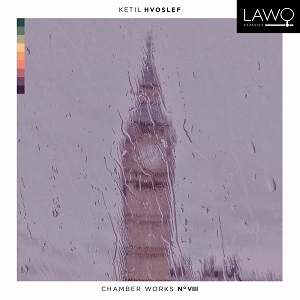
Ketil Hvoslef (b. 1939)
Chamber Works N° VIII
String Quartet No. 1 (1952)
String Quartet No. 4 (2007)
Octopus Rex for eight cellos (2010)
Concerto for Violin and Pop Band (1979)
rec. 2019/22, Gunnar Sævigs sal, Grieg Academy & Studio A, Stein Rokkans hus, University of Bergen, Bergen, Norway
Lawo Classics LWC1246 [50]
This is my first encounter with Ketil Hvoslef, a leading Norwegian composer, the son of Harald Sæverud, one of Norway’s significant twentieth-century masters. As a young man, Hvoslef was part of the jazz and pop scene in Bergen, member of the city’s first rock band The Mixmasters. Unsurprisingly, then, this disc includes his Concerto for Violin and Pop Band, first performed at a rock festival in 1979. I enjoyed it much more than I had expected. Its sixteen minutes played without a break fall into several sections, each quite short, very imaginative and witty. It is not pop music, but it is infused with the energy of jazz, its rhythms and to a considerable degree aspects of its instrumentation: a drum kit and string bass. The composer points out that it is not a crossover work. The booklet writer Ricardo Odriozola insists that “this concerto ranks amongst Hvoslef’s ‘most classical’ compositions as regards motivic development and balanced form”.
Hvoslef started as a painter and, indeed, his music seems to have an illustrative and colourful aspect. I first listened to an early work, String Quartet No. 1, which I came to realise is not really typical. One arched movement reaches a climax at about six minutes. If you want a comparison, then Ligeti does not seem far away. The piece was written in London, the composer tells us, during the great smog of 1952. That seems to hang over the texture and claustrophobic sound world. Hvoslef was having lessons at the time with Henri Lazarof who did not approve of the music, but the performers’ comments in the booklet describe its eight minutes as “invigorating”.
When in 2007 Hvoslef found himself without a commission, he composed what came out as his String Quartet No. 4. He then put it on “a bottom shelf” for posterity. When this disc was proposed, he dug it out. The work mixes fun with candour and seriousness in another single movement but twice as long. My advice is not to worry about form as we know it. Various ideas repeat and are developed but, as the booklet says, the work “uses Hvoslef’s episodic approach to form”. Three minutes before the end, a mad pizzicato passage appears, strongly based on the opening motifs from Bach’s Double Concerto in D minor, “as indeed are the opening four notes in the viola”.
Octopus Rex is cleverly named not only because of hints at Stravinsky’s Octet but of the eight tentacles of the octopus: this is a work for eight cellists. What immediately hit me was the power of this combination, especially at the start. The cello can cover a wide range, so the effect is rather akin to the string orchestra. Sometimes the cellos answer each other antiphonally, sometimes the mood drops into what Ricardo Odriozola describes as a chorale. The ending is as the start; the incredible density of counterpoint and cascades of pizzicato bring this eight-minute work to a dramatic conclusion.
The performances are outstanding. I assume the composer was at the sessions, listening and advising. He is indeed fortunate to find such brilliant and committed musicians who understand his world and musical requirements.
I shall have to look for the earlier volumes in this series. This is a composer of originality, with consummate skill and experience, who has much to say.
Gary Higginson
Help us financially by purchasing from

Performers
String Quartets 1 and 4
Ricardo Odriozola (violin I), Mara Haugen (violin II), Ilze Klava (viola), Ragnild Sannes (cello)
Octopus Rex (directed by Ricardo Odriozola)John Ehde, Finlay Hare, Markus Eriksen, Tobias Olai Eide, Ragnild Sanees, Marius Laberg, Carmen Boveda, Milca Toskov
Concerto for Violin and Pop Band
Ricardo Odriozola (solo violin), Einar Røttingen (piano), Hakon Sjovik (electric piano), Benjamin Kallenstein (electric organ), Thomas Lossius (electric bass), Sigurd Steinkopf (percussion)


















